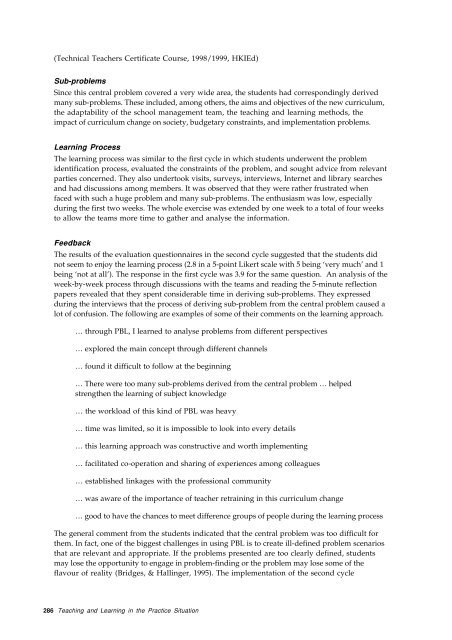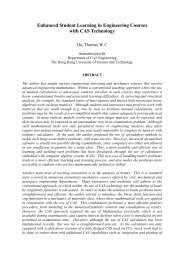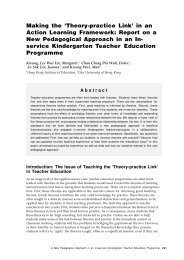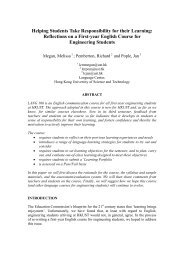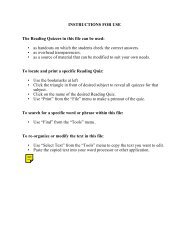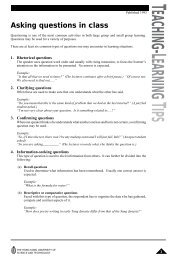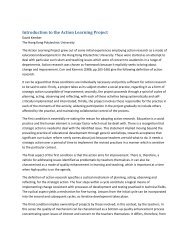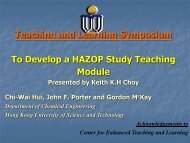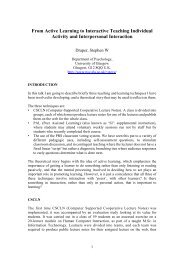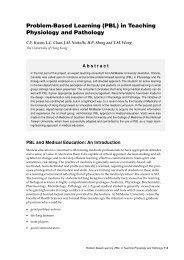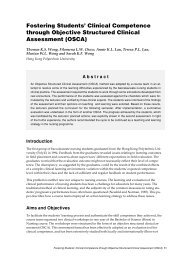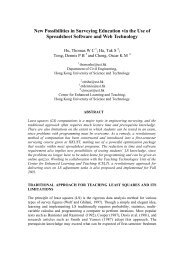Introducing Problem-Based Learning to Teacher Education ...
Introducing Problem-Based Learning to Teacher Education ...
Introducing Problem-Based Learning to Teacher Education ...
You also want an ePaper? Increase the reach of your titles
YUMPU automatically turns print PDFs into web optimized ePapers that Google loves.
(Technical <strong>Teacher</strong>s Certificate Course, 1998/1999, HKIEd)<br />
Sub-problems<br />
Since this central problem covered a very wide area, the students had correspondingly derived<br />
many sub-problems. These included, among others, the aims and objectives of the new curriculum,<br />
the adaptability of the school management team, the teaching and learning methods, the<br />
impact of curriculum change on society, budgetary constraints, and implementation problems.<br />
<strong>Learning</strong> Process<br />
The learning process was similar <strong>to</strong> the first cycle in which students underwent the problem<br />
identification process, evaluated the constraints of the problem, and sought advice from relevant<br />
parties concerned. They also under<strong>to</strong>ok visits, surveys, interviews, Internet and library searches<br />
and had discussions among members. It was observed that they were rather frustrated when<br />
faced with such a huge problem and many sub-problems. The enthusiasm was low, especially<br />
during the first two weeks. The whole exercise was extended by one week <strong>to</strong> a <strong>to</strong>tal of four weeks<br />
<strong>to</strong> allow the teams more time <strong>to</strong> gather and analyse the information.<br />
Feedback<br />
The results of the evaluation questionnaires in the second cycle suggested that the students did<br />
not seem <strong>to</strong> enjoy the learning process (2.8 in a 5-point Likert scale with 5 being ‘very much’ and 1<br />
being ‘not at all’). The response in the first cycle was 3.9 for the same question. An analysis of the<br />
week-by-week process through discussions with the teams and reading the 5-minute reflection<br />
papers revealed that they spent considerable time in deriving sub-problems. They expressed<br />
during the interviews that the process of deriving sub-problem from the central problem caused a<br />
lot of confusion. The following are examples of some of their comments on the learning approach.<br />
… through PBL, I learned <strong>to</strong> analyse problems from different perspectives<br />
… explored the main concept through different channels<br />
… found it difficult <strong>to</strong> follow at the beginning<br />
… There were <strong>to</strong>o many sub-problems derived from the central problem … helped<br />
strengthen the learning of subject knowledge<br />
… the workload of this kind of PBL was heavy<br />
… time was limited, so it is impossible <strong>to</strong> look in<strong>to</strong> every details<br />
… this learning approach was constructive and worth implementing<br />
… facilitated co-operation and sharing of experiences among colleagues<br />
… established linkages with the professional community<br />
… was aware of the importance of teacher retraining in this curriculum change<br />
… good <strong>to</strong> have the chances <strong>to</strong> meet difference groups of people during the learning process<br />
The general comment from the students indicated that the central problem was <strong>to</strong>o difficult for<br />
them. In fact, one of the biggest challenges in using PBL is <strong>to</strong> create ill-defined problem scenarios<br />
that are relevant and appropriate. If the problems presented are <strong>to</strong>o clearly defined, students<br />
may lose the opportunity <strong>to</strong> engage in problem-finding or the problem may lose some of the<br />
flavour of reality (Bridges, & Hallinger, 1995). The implementation of the second cycle<br />
286 Teaching and <strong>Learning</strong> in the Practice Situation


